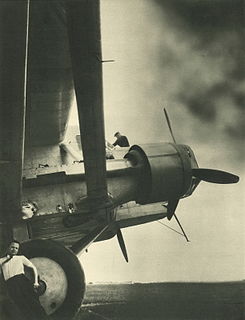
The Farman F.220 and its derivatives were thick-sectioned, high-winged, four engined monoplanes from Farman Aviation Works. Based on the push-pull configuration proven by the F.211, design started in August 1925 and the first flight of the prototype was on 26 May 1932. The definitive F.222 variant was the biggest bomber to serve in France between the world wars. One variant was designed as an airliner.

Potez 25 was a French twin-seat, single-engine biplane designed during the 1920s. A multi-purpose fighter-bomber, it was designed as a line aircraft and used in a variety of roles, including fighter and escort missions, tactical bombing and reconnaissance missions. In the late 1920s and early 1930s, Potez 25 was the standard multi-purpose aircraft of over 20 air forces, including French, Polish and American. It was also popular among private operators, notably mail transport companies.

The Farman F.60 Goliath was a French airliner and bomber produced by the Farman Aviation Works from 1919. It was instrumental in the creation of early airlines and commercial routes in Europe after World War I.
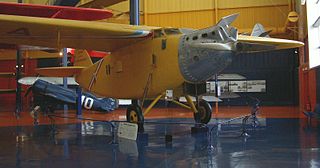
The Bernard 190 or Bernard-Hubert 190 was a French airliner of 1928. It was a high-wing cantilever monoplane of conventional configuration, based on the Bernard 18. Compared with its predecessor, it kept the same basic design but featured redesigned tail surfaces, an enlarged cabin, and offered its flight crew a completely enclosed cockpit. Also like its predecessor, the basic airliner model provided the basis for a long-range aircraft to be used in record attempts, the 191GR.

The Morane-Saulnier M.S.225 was a French fighter aircraft of the 1930s. It was produced in limited quantities to be used as a transitional aircraft between the last of the biplanes and the first monoplane fighters.

The Blériot 165 was a French airliner of the 1920s. It was a four-engined biplane, a final development in the family of designs that began with the Blériot 115. Two were built for Air Union to replace the Farman Goliath on their Paris–London route and were christened Leonardo da Vinci and Octave Chanute. The airline found that it preferred the Lioré et Olivier LeO 21s that it had ordered alongside this aircraft, meaning that no further examples were produced.
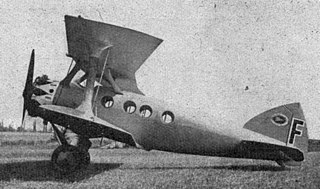
The Blériot-SPAD S.56 was a family of French airliners developed in the 1920s as various refinements of the S.33 design. All S.56 versions shared two new features: the first was a newly designed, all-metal wing, replacing the wooden wing of earlier related designs and the second was a redesigned passenger cabin, replacing the S.33's four single seats in a row with two rows of double seats. A second access door was also added.

The Bleriot-SPAD S.51 was a French fighter aircraft developed in 1924 in response to a French Air Force requirement for an aircraft to replace their obsolete Nieuport-Delage NiD.29s.

The CAMS 55 was a reconnaissance flying boat built in France in the late 1920s which equipped the French Navy throughout the 1930s.

The Farman F.120 and its derivatives were a family of multi-engine airliners and bombers of the 1920s built by the Farman Aviation Works in France.

The Farman F.70 was a 1920s French passenger and mail transport aircraft designed and built by the Farman Aviation Works. It was a smaller counterpart to the company's popular F.60 Goliath. The F.70 was an unequal-span two-bay biplane with a wooden fuselage and was powered by a Renault 12Fe piston engine. The pilot was seated in an open cockpit behind the nose-mounted engine. Behind the open cockpit was a cabin for four passengers or freight.

The Farman F.160 was a heavy bomber aircraft developed in France in the late 1920s. It was essentially an attempt by Farman Aviation Works to modernise its tremendously successful F.60 Goliath design of the immediately postwar years. The most noticeable external difference was the larger tailfin of the new aircraft. Like its predecessor, it was a large three-bay biplane of conventional configuration with unstaggered wings of equal span. Initially conceived as a heavy night bomber, most examples built were float-equipped torpedo bombers for the Aéronautique Maritime, which operated some 40 of the F.165 variant and 200 of the F.168. One of the original F.160 night bombers was exported to Italy, and one to Japan. Plans to develop airliner versions did not progress past the prototype stage.

The Farman F.190 was a utility aircraft built in France in the 1920s and 1930s. It was a high-wing, strut-braced monoplane of conventional configuration with a fully enclosed cabin and fixed, tailskid undercarriage. Popular both as a private aircraft and in the air taxi role, some 30 examples were also operated by airlines in France and elsewhere in Europe. Fifteen of these joined Air France's fleet in 1933 from the fleets of the smaller airlines it had absorbed.

The Farman F.300 and F.310 were airliners built in France in the early 1930s. They were high-wing strut braced monoplanes with fixed tailskid undercarriage with a trimotor layout popular with several manufacturers of the time. The cockpit and passenger compartment were fully enclosed. Most saw service in Farman's own airline, whose twelve F.300 variants made up half its fleet in 1931.

The Lioré et Olivier H-190 was a flying boat airliner produced in France in the late 1920s. Conventional for its day, it was a single-bay biplane with un-staggered wings, its single engine mounted tractor-fashion underneath the upper wing and supported on struts in the interplane gap. Early examples had the pilot's open cockpit located aft of the wing, but this was later relocated forward of the wing.
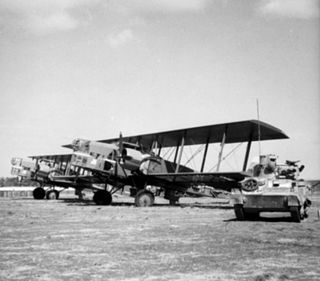
The Lioré et Olivier LeO 25 was a bomber aircraft produced in France in the late 1920s.

The Farman NC.470 was a French twin-engined floatplane designed as a crew trainer for the French Navy. It was used in small numbers for both its intended role as a trainer and as a coastal reconnaissance aircraft at the start of World War II.
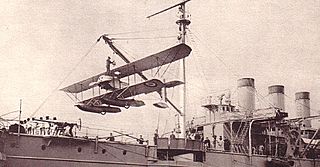
The Caudron J Marine was an amphibious, two-seat, biplane equipped with floats and wheels, similar to the earlier Caudron J floatplane.

The Farman F.211 was a French four-seat day or night bomber designed and built by the Farman Aviation Works for the French Air Force.

The Blériot-SPAD S.91 was a French light-weight fighter aircraft. It would be later developed into the Blériot-SPAD S.510, the last biplane produced by the French aeronautic industries.